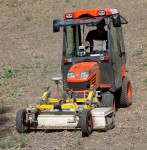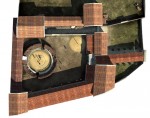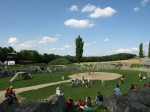 Using cutting edge ground-penetrating radar technology, archaeologists from the Ludwig-Boltzmann Institute have discovered extensive remains of a large gladiator school under the Roman legionary city of Carnutum, 24 miles east of Vienna.
Using cutting edge ground-penetrating radar technology, archaeologists from the Ludwig-Boltzmann Institute have discovered extensive remains of a large gladiator school under the Roman legionary city of Carnutum, 24 miles east of Vienna.
 The site was first surveyed with ground-penetrating radar in 1996. Evidence of structures was detected, but the technology wasn’t keen enough to give researchers a clear idea of what was under there. This latest and greatest radar was attached to the front of a tractor and relayed real-time three-dimensional images of what was underground.
The site was first surveyed with ground-penetrating radar in 1996. Evidence of structures was detected, but the technology wasn’t keen enough to give researchers a clear idea of what was under there. This latest and greatest radar was attached to the front of a tractor and relayed real-time three-dimensional images of what was underground.
It’s the first gladiator training school found outside of Italy and it appears to be excellently preserved.
The Vienna institute team has been able to make detailed images of the gladiator school. They reveal that its centre was dominated by a circular arena equipped with wooden benches.
The school houses a heated training hall which combatants would have used during cold central European winters. There are also a bath house, administrative offices and small cell-like rooms for the gladiators themselves.
 The school complex spread over 2,800 square meters (3,350 square yards) and was surrounded by a thick wall. Outside the walls was a cemetery. The tombs are elaborate, far more so than in a nearby cemetery from around the same time. The fancy burials could indicate that this was a cemetery set apart for gladiators killed in the games. Gladiators were slaves and were on the social fringes, but success in the arena made them popular heroes, so after their gory deaths gladiators would be buried in style.
The school complex spread over 2,800 square meters (3,350 square yards) and was surrounded by a thick wall. Outside the walls was a cemetery. The tombs are elaborate, far more so than in a nearby cemetery from around the same time. The fancy burials could indicate that this was a cemetery set apart for gladiators killed in the games. Gladiators were slaves and were on the social fringes, but success in the arena made them popular heroes, so after their gory deaths gladiators would be buried in style.
Inside the walls there is a courtyard with a small 19-square meter (23-square yard) stadium where the gladiators could practice and put on show fights for visitors and trainers. When it was too cold outside, they would train in the hypocaust heated hall. Don’t be fooled by the heated floors and baths. The gladiators were hardly living in the lap of luxury. Their sleeping cells — because calling them bedrooms would be far too generous — were tiny, just five feet square. There were 40 of these sleeping cubicles in the complex.
 The school was right next door to one of two amphitheaters in town. One amphitheater was part of the army garrison and reserved for the legionaries’ blood sport enjoyment; the other, part of the civil town. The school was adjacent to the civil amphitheater, the remains of which are still visible today and are, serendipitously enough, host to a summer gladiator training school.
The school was right next door to one of two amphitheaters in town. One amphitheater was part of the army garrison and reserved for the legionaries’ blood sport enjoyment; the other, part of the civil town. The school was adjacent to the civil amphitheater, the remains of which are still visible today and are, serendipitously enough, host to a summer gladiator training school.
There are no plans currently to excavate the remains. Only a fraction of the Carnutum site has been excavated so far, and the success of the radar scans will allow archaeologists to make a detailed model of the complex without having to touch spade to soil.
I wonder what the average height of a gladiator was if the sleeping cells were just five feet square. 😮
The average height of a Mediterranean male in the 1st century was 168 centimeters, or 5’5″. Gladiators could have come from all over, of course, but even the tallest (northeastern Europeans) just passed 170 centimeters in average height. Short as they were, they sure as hell couldn’t have been comfortable in 5 foot cells. You’d think even enslaved athletes would be given enough space to stretch their legs.
The Carnutum website would make Walt Disney proud — fantasy characters all dressed up, tours, events, the works! The legionairess in her armor is particlularly comely. Did they have lipstick back then, too? Yikes!
😆 They didn’t, actually. Or rather, we haven’t found any evidence of lip color in the Roman historical record although we have in earlier cultures.
The Mesopotamians invented lipstick even before the wheelbarrow.
You are!
Austrian gladiator school??? Is the Ah-nuld looking for a gig?
He is unemployed. On the other hand, he’s probably too old to go back on the roids and let’s face it, if he couldn’t lift weights without them when he was 20, he certainly couldn’t fight to the death now that he’s 60.
I am trying to think of something in current day culture/entertainment to compare with the social status and purpose of the gladiators ~ my mind is blank…I will have to come back to this thought. Does anyone else have a correlating comparison? :p This is my favorite face!!
PS ~ If the cleaning staff of the school were “available” for an “afternoon delight”….I am sure Ah-nuld would be there!! Hope everyone knows what I am referencing!!
:giggle:
I would be tempted to offer sports such as the WWE (American entertainment style wrestling) would be a natural descendant of gladiatorial combat. It’s relatively popular, the combatants aren’t paid great sums of money. The major difference is that the intent isn’t to kill or maim the opponent. Other pugilistic endeavors might also be considered: Boxing, Mixed Martial Arts, and so forth.
I think we can definitely make comparisons with modern spectator blood sports, especially in terms of fan reactions to the fights and fighters, but that pesky issue of fighter enslavement really has no contemporary parallels. Even if they are poorly paid, they don’t have to live in a 5×5 cell. Maybe there are underground fights that could work, like, say, in prison. A Death Race meets Fight Club sort of deal.
I could see that with the WWE…and the boxing, etc., as far as the pay is concerned and level of physical aggression….except it seems like the gladiator games had the interest of a larger population base ~ maybe, if capitalism and its influence (which enables athletes to be treated and paid like rock stars), and gained social conscious over an “instrinsic” value to human life did not exist (which is the reason we no longer have “kill” sports – other than the military), American football could somehow be similar ~ as far as the way it is indoctrinated as being a “marker” of American culture and society. Just a thought…. 😎
Response to Ambrosius: Now that is an interesting thought!
Actually there is documentation of it in the old stories (epic poems) and in plenty of Latin text books. though have you ever wondered why, for all of their wonderful advancement, they didn’t live very long? Here is one good possibility… A main ingredient in their cosmetics was arsenic and their aqueducts were lined in lead because it is one of the more malleable metals.
They used lead to sweeten wine too. There is no evidence of Romans using lip color, however. Cosmetics, sure. Foundation, rouge, eye liner and shadow, sure. But no lipstick.
Good morning!
What a treasure – I’ve been to Austria many times and never heard about Carnuntum. Now on my ‘must do’ list.
Interesting comment above by livius drusus, about the Romans using lead to sweeten wine… wonder if this where the vintners of South Steiermark got the idea to use Diethylene Glycol to sweeten their wine? 😆
http://www.austrianalpineholidaysblog.com/?p=815
Could be, although diethylene glycol had already been subject of a major adulteration scandal in the US 50 years earlier. The poison wasn’t added to wine, though; it was used as a solvent to create a liquid version of a popular sulfa-drug. Unlike the later Austrian disaster which thankfully killed no one, this one had a death toll of at least 100 people.
:boogie: 😉 Hi :skull: